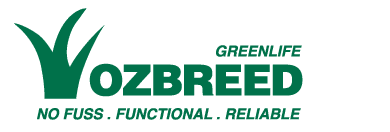Unfortunately Living Soft Fall is no longer being manufactured. At this time there is no other known alternative that is similar.

Prevent compacted ground like this in playgrounds by using Living Soft Fall™.

Living Soft Fall™ prevents the ground from becoming compact if turf dies, making it safe for playground areas.
Until now soft fall areas around play grounds were not allowed to use turf… why?
The reason is twofold:
- Turf does not survive the wear and compaction in playground settings.
- Turf and the soil below it do not meet the fall attenuation requirements of playground standards.
The Solution
A new product called Living Soft Fall™ will help solve the problem of growing turf in fall zones of playgrounds. It is a growing medium that has been tested and certified to meet playground surfacing requirements of AS/NZS4422:1996 Amdt 1.
Turf grown in this media was tested and passed, both when the turf was alive and dead, even when heavily compacted with a compacting machine. In testing the media itself did not compact which shows it is highly resistant to compaction, and even if the turf dies it will still meet soft fall regulations. Living Soft Fall™ and turf can be used in combination with other playground surfaces. E.g. under the swings and in extreme high wear areas, rubber products can be used.
Why use turf in playgrounds:
- Looks more natural than other surfaces
- Is enticing to children
- Can now be safe to fall onto
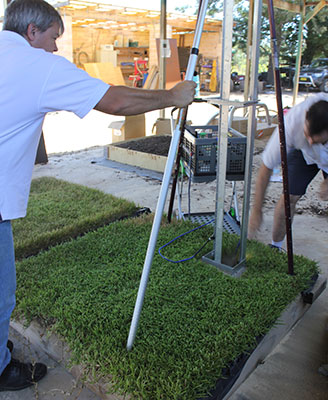
Living Soft Fall™ material was tested to, and exceeds the Australian standard AS/NZS4422:1996 Amdt 1 Playground Surfacing-Specification. In testing, the critical fall height was found to be 4 metres when dry and 5.5 metres when wet.
The Living Soft Fall™ material was installed to a depth of 200mm on top of concrete. Then the turf varieties were established on top and tested both alive, dead, compacted, wet and dry. Sapphire® Buffalo, Kenda® Kikuyu or Nara™ native turf were tested and meet the standards in testing.
For full testing details download the certification.

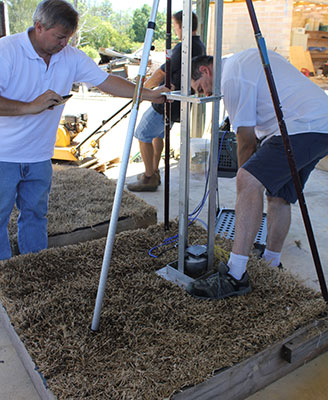
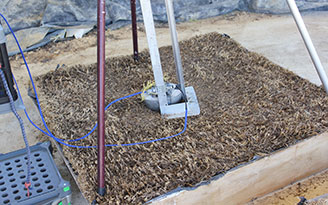
It is a media made up of stabilised organics. By stabilised, we mean they have been well composted and are made of organics that will not significantly slump. This is mixed with a long lasting inert soft rubber carbon polymer that combined with the organics provides a product that has been shown in the tests not to compact, even with a compaction machine. It is also a good growth medium.
This media allows turf to be grown in fall zones of playgrounds whilst complying with the Australian standard AS/NZS4422:1996 Amdt 1 Playground Surfacing-Specification.
Why you should use Living Soft Fall™ and Turf as part of your next Playground surface.
-
-
-
Better environment:
Natural areas need to be increased. 202020 vision has shown the need for increased green space. Increased green life has the obvious advantages of cooling our cities, increasing oxygen production, and the increase in health and wellbeing of people. Green infrastructure enhances the healthiness, livability and sustainability of urban environments. Read more about 202020 vision here.
-
Better health for our children:
Children who are exposed to scenes of nature while exercising are more likely to experience health-enhancing effects after activity, including lower blood pressure. There are many physical and mental health benefits for children proven by various research projects, showcased by these websites:
http://www.childreninnaturensw.com.au/why-nature-play/
http://www.natureplaywa.org.au/research
https://natureplaysa.org.au/research/
http://www.natureplayqld.org.au/resources/resources-for-researchers -
Safe, even if turf dies:
Living Soft Fall™ and turf has been shown to be safe at a minimum critical fall height of 4 metres. Although most heights in play grounds require up to 2.2 metres and the maximum allowed is 3m, it shows how safe turf can be with the right subsurface. Turf grown in this media was tested and passed, both when the turf was alive and dead, even when heavily compacted with a compacting machine. Even if the turf dies it will still meet the Australian Standard.
-
Highly resistant to compaction:
In testing the media itself did not compact which shows it is highly resistant to compaction. The media aids in wearability due to its non-compactive nature.
-
Cost effective and safer than rubber:
The fall heights of Living Soft Fall™ and turf are generally much higher than rubber, artificial turf and mulch, making it a safer product. Wet pour rubber can only support fall heights of up to 2.5m and can cost around $200/m2 or more. Living Soft Fall™ and turf supports a minimum of 4m and costs approximately $55/m2 *
-
Cooler on a hot day:
Living Soft Fall™ with turf is safe even on a hot day, and a child will not burn their feet. A child is at risk of a burn when a surface exceeds 50°C. Rubber surfaces can reach above 60°C on a hot day according to Kidsafe. Recent research on a 40°C day showed that turf was 45.65°C, whilst artificial turf was 66.95°C. Wood mulch was 64.15°C in the full sun. The plastic playground equipment was 70.25°c, and surprisingly the metal playground equipment was 62.35°c.
-
Can be used in conjunction with rubber:
Living Soft Fall™ and turf can be used in combination with other playground surfaces. E.g. under swings, thoroughfares and in extreme high wear areas, rubber products can be used.
-
Stabilised by turf roots:
The Living Soft Fall™ mix used with turf cuts down the issue of frequent replacement and maintenance that loose mulch has, as the turf stabilises and provides retention with its roots and rhizomes. We do not expect the Living Soft Fall™ material to slump significantly or deteriorate in 5 years.
-
More than just fall zones:
Living Soft Fall™ and turf can be also be used for surfaces outside the fall zone, allowing the use of portable equipment and provides a safer surface for general playground play. Moveable play equipment with a climbing height 600mm or more above ground level must be set up on impact attenuating playground surfacing. Living Soft Fall™ and turf fits the bill perfectly whilst giving a natural play surface. For more info on moveable equipment from Kidsafe click here.
-
-
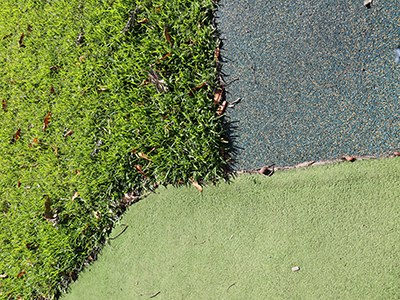
Note: # Turf is a living thing, if not cared for correctly or there is extreme wear, patches can sometimes occur. If it does die or wear out, as the material underneath is loose it may be displaced by children playing on it (like bark soft fall). This needs to be considered, in high wear areas an extra material allowance in case of this possibility is recommended.
* This price is including cost of materials, turf and installation. Higher prices apply for smaller quantities.
Turf selection is important for the success of the Living Soft Fall™ system in a playground. The three varieties below were tested with the Living Soft Fall™ material and comply with the Australian Standard AS/NZS4422:1996 Amdt 1 Playground Surfacing-Specification
If a high amount of traffic is expected e.g. inner city playgrounds with large amounts of visitors each day, we highly recommend the use of Play Matta™ Safety grass retention tiles (complies with the Australian Standard) and Living Soft Fall™ together. Even the hardest wearing turf has its limitations with wear. Please see more info under the Design/Installation headings.
For shade areas: SAPPHIRE® Buffalo Turf ‘B12’ PBR is ideal in up to 50% shade for wear areas. It also does well in full sun. Well suited to smaller playgrounds and day care centres. For more information on Sapphire® Buffalo click here.
For high wear areas: KENDA® Kikuyu Turf ‘KIK203’ PBR is suitable for up to 15% shade, but is by far the hardest wearing turf and performs best in full sun. It has vigorous rhizomes and runners, and will quickly recover from wear. It’s what is used for race courses, football fields etc. It’s the recommended option for most playgrounds in full sun (most of Australia except for humid regions of QLD). It is also highly recommended as the only turf option for extreme high traffic areas and highly used playgrounds. For more information on Kenda® Kikuyu click here.
For low maintenance areas: Nara™ Native Turf Zoysia ‘MAC03’ PBR is a low maintenance tough wearing turf, ideal for areas that require less mowing. It works well in up to 30% shade with wear. Suitable for most playgrounds and day care centres. For more information on Nara™ Native Turf click here.
Aspect: Shade, sun, salt spray etc. will have a bearing on turf selection. If there are areas with more than 50% shade another surface is recommended due to the amount of wear playgrounds can get. See Turf Selection heading.
Existing soil and drainage: For the health of the turf, topsoil/underlay is recommended (see Installation for details). If good drainage is required then sandy loam soil is recommended. Alternatively excavate 200mm of substrate and place the Living Soft Fall™ material in place. Drainage agricultural pipe is recommended to allow water to run off outside the area if the site soil is heavy clay type soil.
High wear areas: There are some areas where even the hardest wearing turf has its limitations. These areas need to be considered in the design and maintenance stages:
- If a high amount of traffic is expected e.g. inner city playgrounds with large amounts of visitors each day. Especially for spots where children may jump off of equipment e.g. climbing frames.
- Thoroughfare areas where large amounts of children are expected to walk along the same track. These high traffic areas are sometimes unpredictable so monitoring for these spots in the first month of use is recommended.
- Under swings, at the end of slides etc. (landing zone around play equipment)
If any of these situations are applicable we highly recommend one of the following options used as per the manufacturer’s specifications:
- Play Matta™ Safety grass retention tiles and Living Soft Fall™ material together (see installation for more details).
- Soft Pour Rubber landing pads under swings, at the end of slides etc. with a standard 45 degree buffer join adjacent to the turf
- Mulch Soft Fall
Note: If the turf wears out the Living Soft Fall™ material underneath, as it is loose, may be displaced by children playing on it (like bark soft fall is). For high wear areas an extra material allowance should be considered in case of this possibility, as turf is a living thing.
Living Soft Fall™ material must be installed to a minimum of 200mm in depth. Based on testing and the Australian Standard AS/NZS4422:1996 Amdt 1 this is a requirement. If high wear areas are expected an additional material allowance is recommended. As it was tested on concrete, any surface will be adequate underneath. Sapphire® Buffalo, Kenda® Kikuyu and Nara™ native turf were tested and meet the standards in testing.
If installing Play Matta™ Safety grass retention tiles: These tiles are recommended for high wear areas to help protect the turf from wear. They are safe to use in playgrounds as they already comply with AS/NZS4422:1996, whilst the Living Soft Fall™ material gives a reliable fall height, is cost effective and provides optimum growing conditions for the turf.
For detailed installation information regarding these tiles, please contact Play Matta as we can only give a guide on how to install them on top of turf/Living Soft Fall™ material.
For most areas and turf types it’s best to avoid the colder months for the turf to quickly establish, and the grass to grow quickly through the tiles. Generally the mats can be laid on top of the Turf/Living Soft Fall™ material 2-3 weeks after installation, allowing another 2-3 weeks wear free before children can play on the area. This timing depends on your location in Australia, the time of year and which turf variety has been selected. As an option to help the turf grow through more quickly, an addition of the Living Soft Fall™ material lightly top dressed on top of the tiles and grass (3-4mm thick) will help the grass grow through quicker.
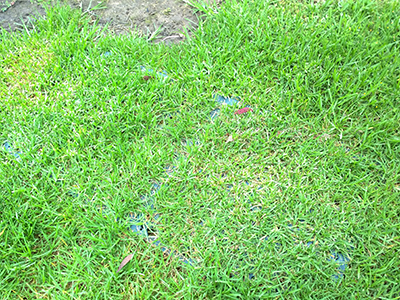
^ Playmatta™ Safety Grass Retention tiles laid on top of Kenda® Kikuyu, 2 months later. After 6-9 months the turf has completely covered over and the tiles are no longer visible.
Below: Living Soft Fall™ installation graphics, including installation details with additional material for high wear areas.
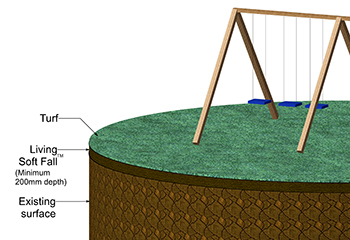
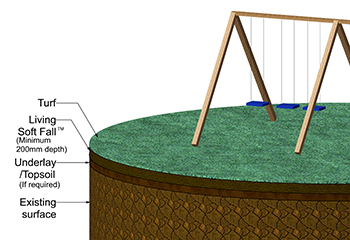
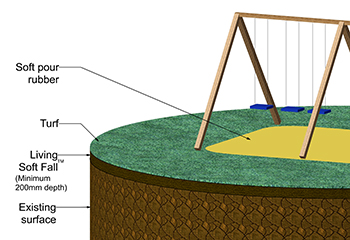
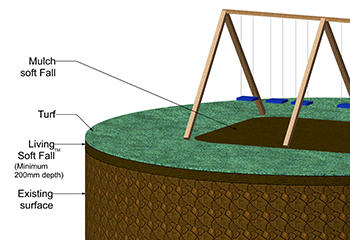
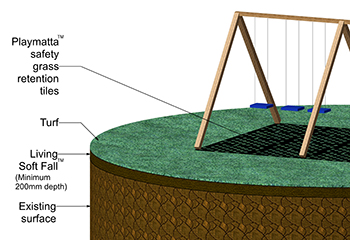
Establishment timeline: After installation, we recommend no traffic on the area for a period of 1 month (this may change depending on your location, time of year and turf type selected). This allows time for the turf to establish adequately. A recommendation for this no traffic period is to install Living Soft Fall™ and turf first. Then, install play equipment after one month so the area can be used immediately after.
Monitoring: As with other forms of playground surfacing it is important to monitor the area for wear and tear. In general all playground surfaces are recommended to have a check conducted within the first 3 months, then an annual check thereafter. Here are some things to look out for:
- 2-4 weeks after first use it is recommended to look for tracks or areas of unexpected high wear. If some areas are starting to be affected by high wear it’s easier to remedy before the turf has completely worn out. However trying to pre-empt high wear areas in the design phase is important. What happens if parts of the turf growing in Living Soft Fall™ material starts to wear out? The simplest option is to place Play Matta™ Safety grass retention tiles on top of the semi worn turf areas and allow the turf to grow through it and recover (see installation for more information).
- If turf has completely worn out in a few spots and left patches, the best option is to replace the dead turf, and immediately put Play Matta™ Safety grass retention tiles on top and restart the normal establishment/maintenance period.
- Although not expected, we estimate after 5 years there may be a need to top dress the turf with Living Soft Fall™ mix to allow for any minor compaction in high wear areas. Most new turf areas may have some small indentations after installation, these will usually settle on their own. If it’s a concern, and the installation hasn’t resulted in a level area, you can also lightly top dress the area with the Living Soft Fall™ material 3-4 weeks after installation.
- Monitor turf health and make sure maintenance practices are carried out correctly.
Recommended turf maintenance: Turf grown on Living Soft Fall™ material can generally be maintained like other turf situations. Once it is established and the roots reach down past the 200mm of growing media into the soil underneath, it will start to become more drought tolerant. The only difference may be in the first summer where it may need a little extra water if compared to a heavy soil that holds more moisture.
It is important to work out in the design process who will be in charge of maintenance, turf is a living thing so will need some care to perform well. In general conditions it won’t need any more maintenance than other turf. However like other turf, in high wear areas it may need a little more care to perform well.
- Mowing will be no different than usual depending on the grass type chosen. Nara™ Native Turf will need the least amount of mowing, Sapphire® Buffalo an average amount, and Kenda® Kikuyu will need more mowing like other Kikuyu, however it will recover from wear more quickly and is the hardest wearing option.
- Watering needs to follow guidelines for establishment and beyond, see the watering tips on the Nara™, Sapphire® or Kenda® websites.
- Fertilising for most lawns only needs to occur twice a year with a quality slow release fertiliser (autumn and spring). However if the playground has high wear, and for the best turf health in general, we highly recommend the following fertilising programme:
- Spring (September) – Spring Blend
- Summer (December/January) – Summer/Autumn Blend
- Autumn (Early April) – Summer/Autumn Blend
- Winter (July) – Summer/Autumn Blend NOTE: Must be a slow release fertiliser as a quick release may cause winter burn. For more info on our winter fertiliser trials click here.
20 cubic metres—$250 per cubic metre
Price Estimates
(including cost of materials, turf and installation)
Fall Zone—200mm thick: $55 per square metre
Outside Fall Zone—100mm thick: $30 per square metre
Notes: Higher prices apply for smaller quantities or when delivered in bulk bags. These prices apply to NSW orders. Interstate prices may be higher. Please contact Ben from Grange Growing Solutions to discuss pricing.
